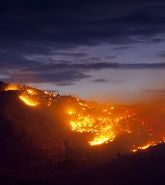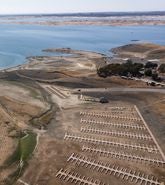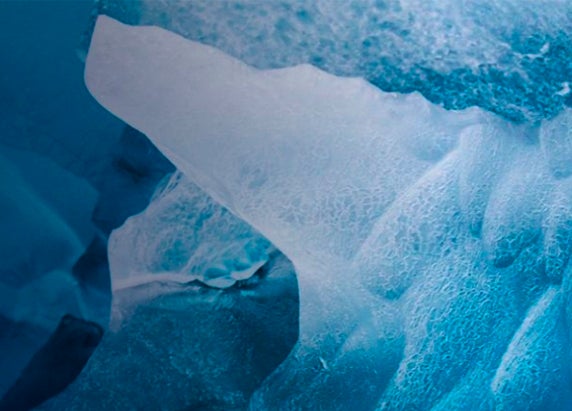The world is warming, and since the year 2000, there have been at least 62 countries that have experienced record maximum temperatures. Cities and regions in 25 countries broke their hottest temperature records last year, and the heatwave in Europe this July has seen new records being set.
The U.K. recorded its highest temperature on July 19. Coningsby in Lincolnshire, a village close to England’s east coast around 130 miles (209 kilometers) north of London, recorded a temperature of 40.3 degrees Celsius (104.5 degrees Fahrenheit).
So, what do we need to consider when assessing the significance of high temperatures as a hazard? We should recognize that there are two distinct perils: drought heat and humid heat.
Type 1: Drought Heat
A lack of precipitation and high temperatures combine to determine the severity of a drought. The Palmer Drought Severity Index, the most commonly used index, employs both temperature and precipitation data to measure the depth of the moisture deficit. The less evaporative cooling at ground level, the hotter the air temperature will be. High temperatures are then a consequence of drought.
Drought severity affects anything rooted in the soil. The more intense the drought, the greater the water deficit that will kill even deeply rooted crops and trees – and cause clay soils to shrink, leading to the displacement of shallow building foundations. Heat and drought together also significantly raise the risk of wildfire.
Building Subsidence Following Heat and Drought
In both the U.K. and France, the movement of building foundations has been a catastrophic source of insurance claims. When a number of years pass without an extended summer drought, vulnerability can increase where tree roots have penetrated further under properties.
In France, insurance claims for building subsidence can only be successful if they follow the government’s declaration of a “catastrophe naturelle” for that specific municipality. Although it typically takes 18 months for a declaration to be issued after the causative drought.
Since 1989, drought-related subsidence has been the second largest source of French “cat nat” losses (after flood) and, according to Swiss Re, the number one peril since 2015.
The most expensive French subsidence catastrophe followed the summer of 2003 with its record heat wave and drought, which led to claims totaling 1.1 billion euros, according to the state-backed reinsurer Caisse Centrale de Réassurance. One-fifth of the area of the French mainland, including four million houses, is underlain by clay soils vulnerable to subsidence.
An increase in subsidence claims from climate change is predicted. By 2030, 3.9 percent of U.K. properties are expected to be affected by subsidence, rising to 11 percent by 2070.
Type 2: Humid Heat
Unrelated to drought conditions, the second heat hazard is humid heat – when high temperatures are accompanied by high humidity. This type of heat is the most dangerous to human health as it threatens the degree to which human perspiration provides evaporative cooling.
In a dry desert environment, while the temperatures may be high, the humidity is typically low. So evaporative cooling of sweat ensures the human body can remain below temperatures critical for functioning.
The key parameter is the “wet-bulb temperature” (or TW), measured on a traditional thermometer with a wet cloth wrapped around the glass bulb. Evaporative cooling lowers the measured temperature until the surrounding atmosphere is saturated with water vapor.
The lower the humidity, the greater the difference between the wet-bulb and dry-bulb temperatures. If the surrounding atmosphere is already saturated with water vapor, then at 100 percent humidity the wet-bulb thermometer would give the same reading as the dry bulb.
Danger to Health
When the wet-bulb temperature rises close to body temperature, the body can dangerously overheat. With TW at 32 degrees Celsius (89.6 degrees Fahrenheit), a person cannot work outside, even in the shade. Experiencing a wet-bulb temperature of 35 degrees Celsius (95 degrees Fahrenheit) for a prolonged period is the limit of human survivability.
Revisiting actual temperature measurements has shown that dangerous TW values have occurred far more frequently than previously recognized. Such events have typically been local in extent and relatively short-lived (only lasting a few hours) and may not be captured in “reanalysis data,” which is averaged in both space and time. These outbreaks have principally been in coastal locations in the subtropics.
Between 1979 and 2017, the occurrence of extreme TW exceedances of 27, 29, 31, and 33 degrees Celsius (80.6, 84.2, 87.8, and 91.4 degrees Fahrenheit) has almost doubled. One survey identified over 7,000 occurrences of TW greater than 31 degrees Celsius (87.8 degrees Fahrenheit), 350 above 33 degrees Celsius (91.4 degrees Fahrenheit), and two stations with multiple daily TW higher than 35 degrees Celsius (95 degrees Fahrenheit).
Even wet-bulb temperatures of 26 degrees Celsius (78.8 degrees Fahrenheit) can be dangerous for those with preexisting health conditions. In the 2003 European heatwave, for example, there were thousands of additional deaths among the elderly and the sick living in poorly ventilated attic rooms.
From climate model outputs, regions most likely to experience dangerous outdoor wet-bulb temperatures in the next 30–50 years include South Asia, the Persian Gulf, and the Red Sea. Extending out to 2070, these could be joined by eastern China, southeast Asia, and Brazil.
Worst impacted, in terms of the population numbers affected (up to 1 billion) and relative poverty, will be citizens living in the Ganges and Indus River valleys extending over northern India, Pakistan, and Bangladesh. High emissions trajectories show these regions will be affected by dangerous wet-bulb temperatures later in the twenty-first century.
Even when not reaching these dangerous levels, there will be adverse health impacts for those who have to work outside. This includes farmers or construction workers, in particular those who are old or poor and have no access to air conditioning.
In May 2021, Qatar expanded regulations prohibiting outside work in the 5 to 6 hottest hours of the day during the summer months, and all work must stop whenever the wet-bulb temperature reaches 32.1 degrees Celsius (89.8 degrees Fahrenheit). In the U.S., within 50 years wet-bulb temperatures may reach dangerous limits a few times each year in states such as Arkansas, Missouri, and Iowa.
The principal “remedy” for both drought heat and humid heat is air conditioning. Cities will be expected to have contingency plans for cooling stations to be opened when a heat wave is forecast. However, peak demand power generation capacity may be threatened when water shortages limit hydropower or low flows in rivers reduce the cooling capacity for nuclear power plants. Power outages in turn could raise mortality rates when air conditioning ceases to function.
Insurance Implications
Humid heat may increasingly be covered in event cancellation insurance for outdoor events when forecasted temperatures are considered dangerous. Those who are at greatest risk from humid heat, workers in agriculture or construction, may be less likely to hold life insurance, but their employers could be liable for adverse health impacts.
Insurers need to recognize the differences between these two heat perils and the significant impact they have on property, infrastructure, and the populations living in affected areas – as the level of future insurance claims will inevitably rise.
Learn more about how RMS® is working to understand the ways climate change is impacting regions around the globe.








